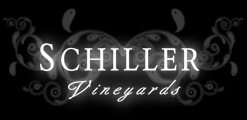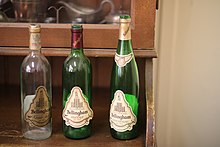
New World wines are those wines produced outside the traditional winegrowing areas of Europe and the Middle East, in particular from Argentina, Australia, Canada, Chile, Mexico, New Zealand, South Africa and the United States. The phrase connotes a distinction between these "New World" wines and those wines produced in "Old World" countries with a long-established history of wine production, essentially in Europe, most notably: France, Italy, Germany, Spain and Portugal.

McLaren Vale is a wine region in the Australian state of South Australia located in the Adelaide metropolitan area and centred on the town of McLaren Vale about 38 kilometres (24 mi) south of the Adelaide city centre. It is internationally renowned for the wines it produces and is included within the Great Wine Capitals of the World. The region was named after either David McLaren, the Colonial Manager of the South Australia Company or John McLaren (unrelated) who surveyed the area in 1839. Among the first settlers to the region in late 1839, were two English farmers from Devon, William Colton and Charles Thomas Hewett. William Colton established the Daringa Farm and Charles Thomas Hewett established Oxenberry Farm. Both men would be prominent in the early days of McLaren Vale. Although initially the region's main economic activity was the growing of cereal crops, John Reynell and Thomas Hardy planted grape vines in 1838 and the present-day Seaview and Hardy wineries were in operation as early as 1850. Grapes were first planted in the region in 1838 and some vines more than 100 years old are still producing. Today there are more than 95 cellar doors in McLaren Vale. The majority are family-run operations and boutique wineries.
South African wine has a history dating back to 1659 with the first bottle being produced in Cape Town by its founder and gouverner Jan van Riebeeck. Access to international markets led to new investment in the South African wine market. Production is concentrated around Cape Town and almost exclusively located within the Western Cape province, with major vineyard and production centres at Constantia, Paarl, Stellenbosch and Worcester.

The Walla Walla Valley AVA is an American Viticultural Area located within Washington state and extending partly into the northeastern corner of Oregon. The wine region is entirely included within the larger Columbia Valley AVA. In addition to grapes, the area produces sweet onions, wheat and strawberries. After the Yakima Valley AVA, the Walla Walla AVA has the second highest concentration of vineyards and wineries in Washington State. Walla Walla hosts about 140 wineries.

Texas has a long history of wine production. The sunny and dry climate of the major winemaking regions in the state have drawn comparison to Portuguese wines, in addition to other regions in Europe like Spain, France, and Italy. Some of the earliest recorded Texas wines were produced by Spanish missionaries in the 1650s near El Paso. Texas ranked as the fifth largest wine producing state by 2019.

Schiller Vineyards located in the wine region of Barossa Valley, South Australia; was established back in 1864 when the first vines were planted by Carl Freidrich Schiller. Carl arrived in 1855 to South Australia and settled in the small Barossa village of Light Pass. Schiller Vineyards today is a sixth generation family owned and operated vineyard, and producer of aged red wines.

The South Australian wine industry is responsible for more than half the production of all Australian wine. South Australia has a vast diversity in geography and climate which allows the state to be able to produce a range of grape varieties–from the cool climate Riesling variety in the Clare Valley wine region to the big, full bodied Shiraz wines of the Barossa Valley.

Victorian wine is wine made in the Australian state of Victoria. With over 600 wineries, Victoria has more wine producers than any other Australian wine-producing state but ranks third in overall wine production due to the lack of a mass bulk wine-producing area like South Australia's Riverland and New South Wales's Riverina. Viticulture has existed in Victoria since the 19th century and experienced a high point in the 1890s when the region produced more than half of all wine produced in Australia. The phylloxera epidemic that soon followed took a hard toll on the Victoria wine industry which did not fully recover till the 1950s.

Provence (Provençal) wine comes from the French wine-producing region of Provence in southeast France. The Romans called the area provincia nostra, giving the region its name. Just south of the Alps, it was the first Roman province outside Italy.

New South Wales wine is Australian wine produced in New South Wales, Australia. New South Wales is Australia's most populous state and its wine consumption far outpaces the region's wine production. The Hunter Valley, located 130 km (81 mi) north of Sydney, is the most well-known wine region but the majority of the state's production takes place in the Big Rivers zone-Perricoota, Riverina and along the Darling and Murray Rivers. The wines produced from the Big Rivers zone are largely used in box wine and mass-produced wine brands such as Yellow Tail. A large variety of grapes are grown in New South Wales, including Cabernet Sauvignon, Chardonnay, Shiraz and Sémillon.

Fairview Wine and Cheese farm is a South African producer of wines and cheeses based in the Paarl region of the Western Cape province. It is owned and run by Charles Back, who also owns The Goats do Roam Wine Company and The Spice Route Winery.

British Columbia wine is Canadian wine produced in the province of British Columbia. Wines made from 100% British Columbia grapes can qualify for classification under one of British Columbia's two classification systems, depending on the variety, the winemaking techniques employed, and various other restrictions.

Henschke is a family-owned, 155-year-old Australian winery, located in Keyneton, South Australia in the Eden Valley wine region. It produces the 'Hill of Grace', one of Australia's "cult wines", and was considered Australia's second best wine by James Halliday in 2009.

The Barossa Valley wine region is one of Australia's oldest and most premier wine regions. Located in South Australia, the Barossa Valley is about 56 km northeast of the city of Adelaide. Unlike most of Australia whose wine industry was heavily influenced by the British, the wine industry of the Barossa Valley was founded by German settlers fleeing persecution from the Prussian province of Silesia. The warm continental climate of the region promoted the production of very ripe grapes that was the linchpin of the early Australian fortified wine industry. As the modern Australian wine industry shifted towards red table wines in the mid-20th century, the Barossa Valley fell out of favor due to its reputation for being largely a Syrah from producers whose grapes were destined for blending. During this period the name "Barossa Valley" rarely appeared on wine labels. In the 1980s, the emergence of several boutique families specializing in old vine Shiraz wines began to capture international attention for the distinctive style of Barossa Shiraz, a full bodied red wine with rich chocolate and spice notes. This led to a renaissance in the Barossa Valley which catapulted the region to the forefront of the Australian wine industry.
Cono Sur Vineyards & Winery is a subsidiary of Concha y Toro Winery and is the third largest exporter of bottled wine in Chile. Established in 1993, its name is a reference to its location in the Southern Cone of South America and a play on the word connoisseur. In 2015, it was the official wine of the Tour de France.

Adelaida Vineyards & Winery is a family-owned and operated winery that was named after a 19th-century settlement in the mountains of west Paso Robles, California. Situated at 2,000 feet (610 m) of elevation and 14 miles (23 km) from the Pacific Ocean, the terrain of the Adelaida, California district is marked by ancient calcareous soils, diurnal temperature variations of nearly 50 °F (10 °C), and warm, dry growing seasons. Adelaida Vineyards & Winery produces Cabernet Sauvignon, Pinot noir, Syrah, Rhône blends, Zinfandel and other wines from the Paso Robles AVA.

Breaux Vineyards is a Cajun owned and operated winery and vineyard located in Purcellville, Loudoun County, Virginia. Founded by E. Paul Breaux, Jr. in 1997, the 100% estate grown winery was one of three United States wineries to be named in the book "250 Best Wines 2012" by Oz Clarke for their Viognier, which landed at #87 in the publication. Breaux Vineyards is one of Virginia's largest grape growers & suppliers of wine grapes, bulk juice, and bulk wine to other East Coast U.S. wineries. The company logo is a red Crawfish, which pays homage to the Breaux family's Cajun heritage because they are often used in the local Cajun cuisine in Louisiana.

Red Willow Vineyard is a grape-growing estate located in the far western end of Yakima Valley AVA, within the Yakama Indian Reservation. Beginning with their relationship with Columbia Winery and Master of Wine David Lake, grapes from Red Willow have been used to produce some of the most critically acclaimed Washington wines with the vineyard's name regularly being featured on vineyard designated wines. Paul Gregutt, wine writer for the Seattle Times and Wine Enthusiast, list Red Willow as one of the "top ten" vineyards in the entire state.

Force Majeure is a Washington/Oregon wine estate, specializing in Syrah, Cabernet Sauvignon as well as other Bordeaux and Rhone-inspired blends. The brand was founded in 2004, and beginning with that vintage Force Majeure began the "Collaboration Series" of wines made by some of Washington's top winemakers, using fruit from Red Mountain's Ciel du Cheval vineyard.



















